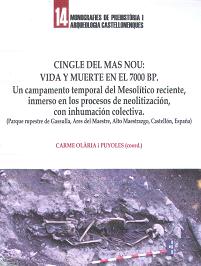 |
[Paléolithique et Mésolithique]
Carmen Rosa Olaria Puyoles (2020) - Cingle del Mas Nou: 7000 BP. Un campamento temporal del Mesolítico reciente, inmerso en los procesos de neolitización, con inhumación colectiva. (Parque rupestre de Gassulla, Ares del Maestre, Alto Maestrazgo, Castellón, España), Castelló, Servei d'Investigacions Arqueològiques i Prehistòriques Diputació de Castelló, 384 p. EAN 9788417465100, 0,00 €.
The Cingle of Mas Nou (Ares del Maestre, Castelló, Spain) site, albeit small and modest, has given us a fairly approximate view of two important aspects about human groups or small tribes, that existed at the end of Me4solithic, in territories of 1000 m. above sea level, in the mountains of Maestrazgo. In fact, the first aspect has brought us closer to the types of burials they made, both primary and secondary. The second aspect, that it has shown us how they lived, in this period. Although the structures of their habitat were destroyed by anthropogenic and natural causes, however, we have been able to gather their material culture. The materials of lithic industry have a great variety for this Mesolithic moment until to Neolithic transition. The applied statistics has shown us the homogeneity of the industry, whose identification as “Mesolithic geometrics”, backed bipoint (BPD) to Laplace typology, however these useful features are surpassed by the presence of backed lames (LD), which World mean that Epipaleolithic carving traditions still survived. Also the study of the traces of use of lithic batch has informed us about what materials these tools were used. The sheets were used for cutting and scrapping soft plants and flesh, the notched blades were used to polish the wood, to cut woody plants, to scrape skin, etc. The functions were four: working and polishing wood, cutting meat, scraping and cleaning leather and discarding bones. Cingle of Mas Nou site was associated eith the Cave Fosca site, because the techniques of lithic industry are same. Both sites are located in the Rock Art Park of Gassulla. The stratigraphy of Cave Fosca shows us occupations from the Epipaleolithic to Neolithic. In Cingle of Mas Nou site the occupation was only in the recent Mesolithic. For this reason the Rock Art Park shows examples of engraved art, painted art (Levantine type) and Schematic Art. The Geographic Research Systems (SIG) has allowed us to know not only the closest journeys within its paleohábitat, but also the most distant zones up to the Mediterranean coastal strip. That allows to connect other coastal territories, even reaching the mouth of Ebro river, Bajo Aragón and remote areas High Maestrazgo. These long tours were made in the spring and summer solstices. These displacements reflect a great capacity for mobility, probably similar to that of the Upper Paleolithic groups. The resulta of mitochondrial ASDFN performed on the second and the third molar of adult man, gave result of quantification of genomic and nuclear DNA corresponding to haplogroup U5, common throughout Europe for Mesolithic populations. Its age is estimated between 52.000 to 30.000 years, as the oldest maternal lineage dominant for thousands of years colonizing Europe and appears concentrated mostly in the southern areas of this continent, after the last ice age. In the Iberian Peninsula, haplogroup U5 is concentrated in the North: Cantabria, País Vasco, Pyrenees, Aragon and Catalonia. But now we know how it entered through the Basin of Ebro river also in the North of the Valencia Country. Cingle de Mas Nou was first a burial site, but later it became a hunting camp. Mostly, they hunting deer and mountain goats. Occasionally they hunted wild boars, uros, horses, and there is also evidence of roe deer hunting. They also practiced an opportunistic hunting of lynx, hare and rabbit. Isotopic analysis only determine fish intake among children. But we don’t rule out that adults also took advantage of shell fishing during their trips to the maritime coast. Dairy products are not recorded in isotopic analyzes. Another source of food was obtained from systematic, rotary and seasonal collection, in order to reach food products from vegetables, berries, tubers, nuts etc., but al the same time also healing as medicinal herbs and even palliative pain, such as carries of alkaloids, analgesics and antidotes (Papaver sommniferum sp. Setigerum) in the cave of Arqueros Negros (Alcaine, Teruel). This euphoric plant grows spontaneously in dry places of stony ground. We do not rule out that they collected others types of plants derived from hemp (grief, kef and hashish) in certain dry areas, although more than for their properties of alkaloid contents, which are scarce in the cannabis of Iberian Peninsula, they would be collected to make string ropes. Another co-branded product was honey. Women were specialists as honey collectors as shown by numerous scenes of rock art. Fastened by ropes or mounted on top of each until reaching the honey Carpologic results in Cingle of Mas Nou site have been scarc, reduced to the presence as reed seed (Juncus sp.). But it the nearby site of Cave Fosca, near Cinfle of Mas Nou, the results have been wider, with a landscape of coniferous forest (Pinus sylvestris nigra), oak and hom ocak (Quercus sp.). Collection fruits that have been found are cherry seed (Prunus avium), sloe plum (Prunus spinosa), nectarine (Cotoneaster cf. nebrodensis), mastic tree (Pistacia lentiscus) and mountain savin (Juniperus Sabina). Finally we want to highlight the importance of a cultural period such as the recent Mesolithic, which is distant the Epipaleolithic, whose main feature in the lithic industry is manufacture of backed lames, but in many cases the Mesolithic also incorporates these laminar tools, although it has created an ex novo industry of geometrics, that lasts until the last stages of this culture. The Mesolithic period incorporated new technologies, while retaining others, also ceramics, without renouncing to its subsistence economy. It took an obligatory step to introduce new social, economic and technological changes leading to the introduction and expansion of the production economy.
|
 Actualités
Actualités 

 Actualités
Actualités 
